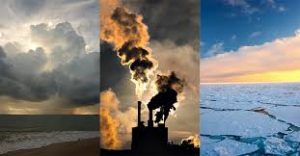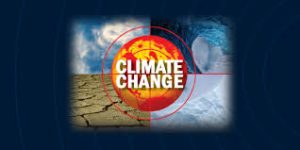
- It is the long term change in the statistical distribution of weather patterns over periods of time
- Though it has been happening naturally for millions of years, in recent years it has accelerated due to anthropogenic causes and has been causing global warming.
- UNFCCC defines climate change as – “a change of climate which is attributed directly or indirectly to human activitythat alters the composition of the global atmosphere and which is in addition to natural climate variability observed over comparable time periods”
Climate Change Mitigation
- Alternative Energy sources
- Renewable energy
- Nuclear Power
- Reduce the carbon intensity of fossil fuels
- Energy efficiency and conservation
- Transport and urban planning
- Building design
- Reforestation and avoid deforestation
- Eliminating waste methane
- Geoengineering
- Greenhouse gas remediation
- Biomass
- Carbon air capture
- Carbon capture and storage
- Societal control
- Population
- Sustainable life-style
- Greenhouse gas remediation
Global Warming
- An increase in the average temperature of Earth’s near surface air and oceans since the mid-20thcentury
- 4thassessment report of IPCC: global temperature increased 74+18 degree C during the 20thcentury.
- Caused by greenhouse gases
- Water vapour, Co2, Methane, Nitrous Oxide, Ozone, CFCs (in order of abundance)
- Since the industrial revolution, the burning of fossil fuels has increased the levels of Co2 in the atmosphere from 280 ppm to 390 ppm.
IPCC
- 1988 by World Meteorological Organisation and UNEP
- tasked with reviewing and assessing the most recent scientific, technical and socio-economic information produced worldwide relevant to the understanding of climate change
- Nobel Prize in 2007
- The IPCC does not carry out its own original research, nor does it do the work of monitoring climate or related phenomena itself.
- A main activity of the IPCC is publishing special reports on topics relevant to the implementation of the (UNFCCC)
- Till now, it has released four assessment reports (1990, 1995, 2001, 2007)
- Fifth assessment report is due in 2014
UNFCCC
1992 at the Rio Summit.
194 members.Secretariat at Bonn.
Parties to UNFCCC are classified as:
- Annex I countries – industrialized countries and economies in transition
- Annex II countries – developed countries which pay for costs of developing countries
- Developing countries.
| Conference | Place | Outcome |
| 1995 COP1 | Berlin | The Berlin Mandate |
| 1996 COP2 | Geneva | |
| 1997 COP3 | Kyoto | Kyoto Protocol |
| 1998 COP4 | Buenos Aires | |
| 1999 COP5 | Bonn | |
| 2000 COP6 /2001 COP6 | The Hague/Bonn | CDM and Joint Implementation adopted at Bonn |
| 2001 COP7 | Marrakesh | |
| 2002 COP8 | New Delhi | Delhi Declaration: Calls for efforts by developed countries to transfer technology and minimize the impact of climate change on developing countries |
| 2003 COP9 | Milan | |
| 2004 COP10 | Buenos Aires | |
| 2005 COP11/MOP1 | Montreal | |
| 2006 COP12/MOP2 | Nairobi | |
| 2007 COP13/MOP3 | Bali | Bali Action Plan |
| 2008 COP14/MOP4 | Poznan, Poland | |
| 2009 COP15/MOP5 | Copenhagen | |
| 2010 COP16/MOP6 | Cancun | |
| 2011 COP17/MOP7 | Durban, South Africa | |
| 2012: COP 18/CMP 8 | Doha, Qatar | |
| 2013: COP 19/CMP 9 | Warsaw, Poland | |
| 2014: COP 20/CMP 10 | Lima, Peru | |
| 2015: COP 21/CMP 11 | Paris, France | |
| 2016: COP 22/CMP 12/CMA 1 | Marrakech, Morocco | |
| 2017: COP 23/CMP 13/CMA 2 | Bonn, Germany |
Tarawa Climate Change Conference
- In the lead up to COP16, the leaders of the world’s most climate-change vulnerable countries met in Kiribati in November 2010
- Ambo Declarationwas adopted
- It calls for more and immediate action to be undertaken to address the causes and adverse impacts of climate change.
CoP-16/CMP-6, Cancun
COP-16 President: Patricia Espinosa, Mexico’s foreign secretary
COP-17 will be held in Durban
Issues
- Forestry issues and reducing emissions from deforestation and forest degradation (REDD) plus
- The developed countries are pushing for transparency from countries where they will fund climate change mitigation.
- The assessment of carbon emission mitigation for developing countries is right now through domestic communication but is subject to international consultation and analysis. This push for transparency is a major contentious issue.
- Fast-track finance: $ 30 bn had been committed at CoP-15. A large part of this funding is yet to come through.
Goals
Agreements Reached
- The outcome of the summit was an agreement, not a binding treaty, which calls on rich countries to reduce their greenhouse gas emissions as pledged in the Copenhagen Accord, and for developing countries to plan to reduce their emissions, to limit global warming to less than 2 degrees celsius above pre-industrial levels.
- There should be no gap between the first commitment period of the Kyoto Protocol, which expires in December 2012, and the second phase.
- The agreement calls on the developed countries to “raise the level of ambition of the emission reductions to be achieved by them individually or jointly, with a view to reducing their aggregate level of emission of green house gases”
- Allows flexibility in choosing the base year for setting emission reduction targets
- Emissions trading and the project based mechanism under the KP shall continue to be available to Annex 1 parties as a means to meet their quantified emission limitation and reduction objectives.
- The agreements recognize that in all climate change related action,human rights must be respected. They also recognise the need to engage with a broad range of stakeholders, including youth and persons with disability, and call for gender equality and effective participation of women and indigenous people in effective action on all aspects of climate change.
- The BASIC group softened the three demands it had before the talks began
- Necessity of a second commitment period to the Kyoto Protocol
- Need to accelerate disbursement under the fast start finance in the form of new and additional resources through a multilaterally supervised mechanism
- Continued dialogue on IPRs as part of the technology development and transfer issues.
- REDDis a part of the package and proposed mitigation actions include conservation and enhancement of forest carbon stocks and sustainable management of forests.
- REDD is a set of steps designed to use market/financial incentives in order to reduce the emissions of greenhouse gases from deforestation and forest degradation. Its original objective is to reduce GHGs but it can deliver ‘co-benefits’ such as biodiversity conservation and poverty alleviation
- REDD+ calls for activities with serious implication directed towards the local communities, indigenous people and forests which relate to reducing emission from deforestation and forest degradation. It goes beyond deforestation and forest degradation and includes the role of conservation, sustainable management of forests and enhancement of forest carbon stocks
- ACancun Adaptation Framework has been proposed to strengthen and address implementation of action, and various kinds of assessments, apart from R&D and host of other issues.
- Green Climate FundThe fund will be designed by a transitional committee, with 15 members from the developed countries and 25 from the developing nations.
- Pledge by the developed countries to provide $100 bn annually till 2020.
Conclusion
- UNFCCC secretary-generalChristian Figueres emphasised that the main achievement of the Cancun meet has been to restore some degree of faith in the multilateral process.
- The agreements don’t mention any reduction targets.
- Though the agreements recognize the need to reduce the GHG emissions and curb the increase in global average temperatures below 2 degrees Celsius above pre-industrial levels, in the absence of any firm target, this could be an inadequate and vague provision
- Bolivia has rejected the agreement, saying that it won’t support agreement without binding emission cuts.
- In a sense, the summit was both a major step forward as well as a failure
- It was a step forward because in recent years climate change negotiations had stumbled and this meeting helped overcome that
- It was a failure because it failed to reach an agreement for binding restrictions that are required to avert global warming.
- There was no agreement on how to extend the Kyoto Protocol, or how the $100 billion a year for the Green Climate Fund will be raised or whether developing countries should have binding emissions reductions.
- GPSC Mains 2024 Tests and Notes Program
- GPSC Prelims Exam 2024- Test Series and Notes Program
- GPSC Prelims and Mains 2024 Tests Series and Notes Program
- GPSC Detailed Complete Prelims Notes


